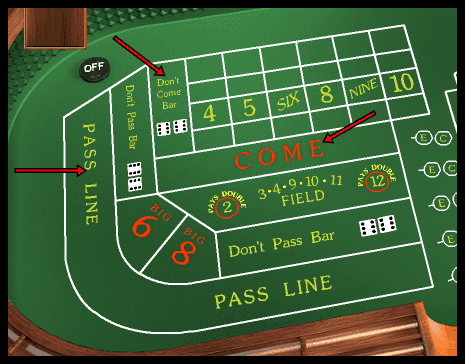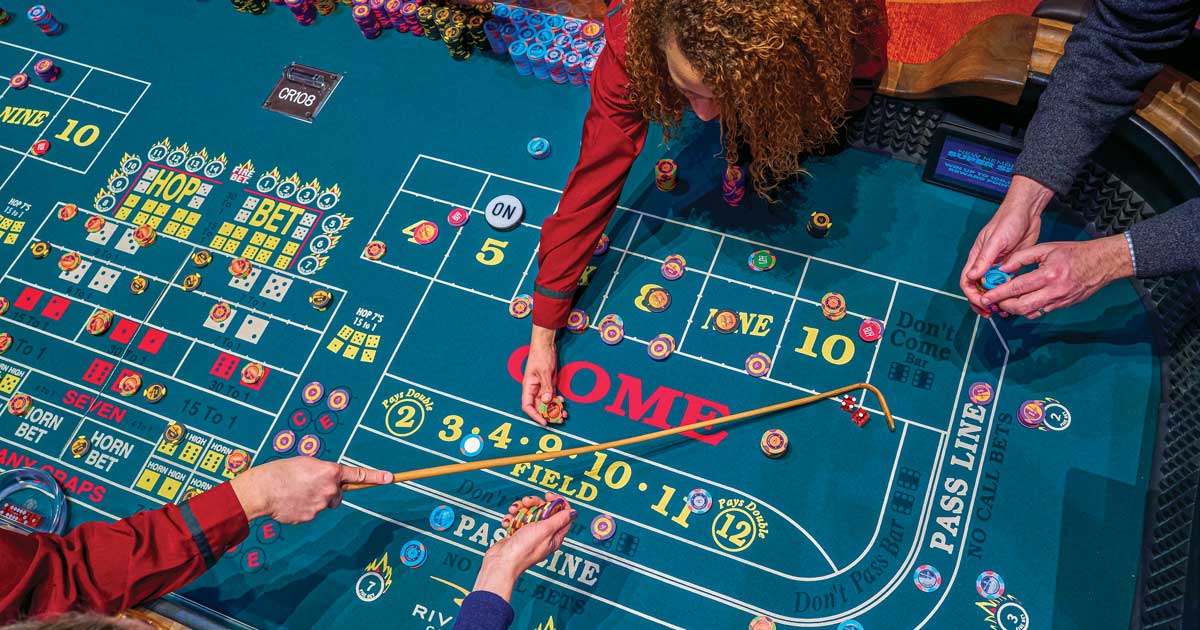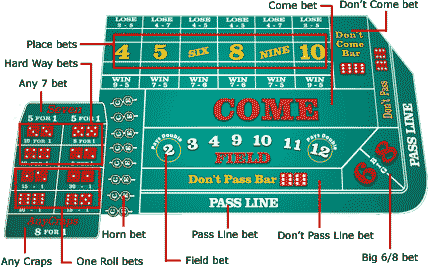When they win, they keep a portion. No way to beat that, right? The only way to beat craps is to know the 'Loop Hole' - enter Dice Control Well, you can't exactly control the dice. I like how the Dice Coach refers to it - Dice Influence. The 'Loop Hole' is the fact that the casino makes money from craps as long as the dice are perfectly random. Now let’s break down that twelve ways to win on the Come Out for a minute. Again, we have $10 on the Pass Line and $2 on the Any Craps. Here’s how it shakes out: Seven rolls: Win $10 on Pass Line – Lose $2 on Any Craps – Net win $8 Eleven rolls: Win $10 on Pass Line – Lose $2 on Any Craps – Net win $8.
Craps is the most iconic casino gambling game. I can easily remember a plethora of TV shows and movies where craps was the game of choice for certain characters. Tony Stark played craps in Iron Man.

Craps is also one of the more intimidating games. There are so many possible bets laid out on the table, new players are easily confused.
In some ways, craps isn’t any more complicated than roulette. But roulette is the easier game to learn.
I think it’s because roulette has a better table layout than craps.
Unlike roulette, craps is played through multiple rounds. You can let it ride in roulette if you keep winning, but in craps, you can place craps bets that remain on the table until certain conditions are met.
Maybe that’s why craps is so popular. A player who wants his money to last while having fun can make wagers that may last much longer than wagers in blackjack, baccarat, roulette, and slots.
The Basic Rules of Craps
Craps is a well-known game but every casino can alter the rules slightly. The table limits may differ. Some casinos may allow a shooter to not make a bet.
At least three casino employees are required to run each craps table:
- Boxman – This person handles the chips and supervises the dealers.
- Stickman – The stickman uses a stick to move the dice around the table when the shooter changes. He also calls out the result of every roll.
- Base dealers – In most games, there is a dealer on each side of the table. They collect losing bets and pay winners. Players may ask dealers to place bets for them.
The game round begins when a shooter is chosen. Players place their bets. The shooter then rolls the dice.
This first roll, the come-out roll, may end the round if the dice total to 2, 3, or 12 (a losing result for “pass bets”) or if they total 7 or 11 (a winning result for pass bets).
If the dice form any other total, the shooter keeps rolling. The initial die roll total becomes “the point.” If the shooter rolls a 7 or the point after the come-out roll, the round ends. Shooters are expected to pass on the dice if they finish the round on 7.
Players can make 22+ types of wagers in craps. Some are much safer than others, and some are much riskier.
Players can make more than one bet.
Basic Craps Strategy – Always Make Safe Bets
Best Ways To Win At Craps
The safest bets are sometimes called “smart craps bets.” They are smart because the house edge is so low and they usually pay off more than other types of bets. There are four types of safe bets: pass, don’t pass, come, and don’t come.
In addition to these safe bets, you can complement your early wagers with odds bets. What follows amounts to the simplest betting system in craps. It’s also the system that is most likely to lead to the most wins.
Some craps players move beyond these strategies because “most wins” doesn’t necessarily translate into “most money won.” You can win more money at craps by making more aggressive bets.
1 – Make Pass and Don’t Pass Bets
The pass bet is the second safest bet with a house edge of only 1.41%.
The don’t pass bet is considered the safest bet in craps because the house edge is only 1.36%. That means for every $10,000 wagered on don’t pass, the house expects to retain $136. Don’t pass is the opposite of pass, when one loses the other wins.
Both pass and don’t pass bets pay even money. It only makes sense to bet one way or the other.
Pass bets that survive the come-out roll pay if the shooter ends the round on the point. Don’t pass bets that survive the come-out roll pay if the shooter ends the round on a 7.
How does don’t pass have a slight advantage over a pass bet? If the shooter rolls a 12 on the come-out roll, pass bets lose, but don’t pass bets are returned to the players (a push).
All things considered, the don’t pass bet has an even chance of winning compared to the pass bet but a slightly better chance of surviving the come-out roll.
2 – Make Come and Don’t Come Bets
The only real difference between these bets and pass/don’t pass is that you make them after the point is established. For all intents and purposes, the next roll is treated as the come-out roll for these bets. come/don’t come bets pay even money and are settled exactly like pass and don’t pass.

In other words, a come bet pays if the shooter ends the round on a 7, and don’t come bets pay if the shooter ends the round on point.
There is no point in leveraging a pass bet against a don’t come bet or vice versa. If one pays, the other loses. You break even.
Think of using come/don’t come bets as a way of safely doubling your wagers on pass/don’t pass bets. Instead of betting $50 before the shooter comes out, you bet $25 before and $25 after.
3 – Make Odds Bets

After the point is established, you can take or lay odds on the number. The payout differs based on which number is point.
Best Way To Win At Craps
Taking odds (a.k.a. buying odds) means you are complementing your pass or come bet. If the round ends on point, your odds bet pays.
Laying odds means you are complementing your don’t pass or don’t come bet. If the round ends on a 7, your odds bet pays.
The great thing about these odds bets is there is no house edge. The casino is taking the same risk as you are.
The payouts on odds bets are as follows:
- 4 or 10 – 2:1 for pass odds and 1:2 for don’t pass odds
- 5 or 9 – 3:2 for pass odds and 2:3 for don’t pass odds
- 6 or 8 – 6:5 for pass odds and 5:6 for don’t pass odds

How To Win At Craps Reddit
Clearly the don’t pass/don’t come bets pay less. If you’re playing basic strategy and want to play the odds, the pass + come strategy offers the better overall payout (for a slightly less chance of winning).
4 – Make Place Bets
If you’re willing to take on more risk, you can make place win or place lose bets. These bets use the same part of the table as the basic odds bets described above, but you can pick any number from the group (4, 5, 6, 8, 9, and 10).
Place win bets win if the chosen number is rolled before the shooter rolls a 7. Place lose bets win if the shooter rolls a 7 before the chosen number is rolled.
To illustrate, if a player wagers $10 for place win on 4, that bet pays off if the shooter rolls a 4 before rolling a 7. If the player wagers $10 for place lose on 4, that bet pays off if the shooter rolls a 7 before rolling a 4.
The payouts on win and lose bets are:
- 4 or 10 – 9:5 for win and 5:11 for lose
- 5 or 9 – 7:5 for win and 5:8 for lose
- 6 or 8 – 7:6 for win and 4:5 for lose
As with the basic odds bets above, the payouts are better for win than for lose. The chances of a lose happening are better.
Conclusion
There are even more options in craps. They become progressively harder to win and pay better. The riskiest bets are proposition bets, offering much higher payouts and much higher house edges.
A beginning craps player has enough options to keep the game interesting for a while. It’s a good idea to vary your betting between the pass and don’t pass basic strategies. The probabilities are so similar they are almost meaningless.
Think of your craps strategy as a set of layered bets. You build a foundation with pass or don’t pass and move up through different ways to win in craps from there.

By watching how the game plays out, you’ll find a favorite way of betting through experimentation while playing it safe at the same time.
Please enable JavaScript to view the comments powered by Disqus.